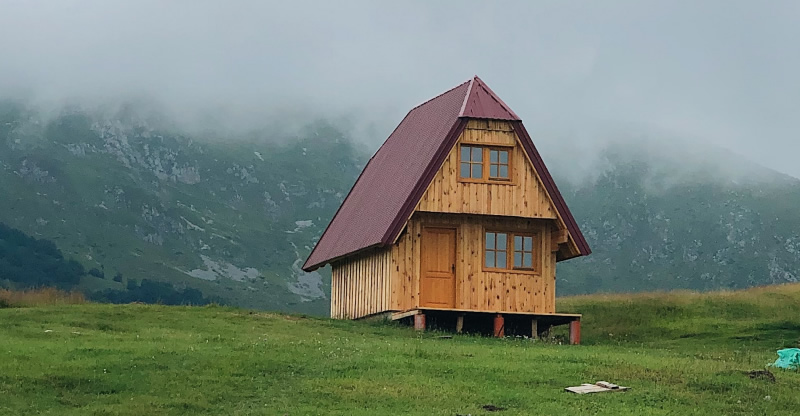
Anyone who has spent time on Instagram scrolling home and lifestyle content will no doubt have noticed a trend gathering pace over the last few years.
Alongside the #vanlife photos and videos of people refurbishing their mini vans to turn them into liveable spaces, and driving them around beautiful landscapes, there are also the not-too-dissimilar tiny houses.
Tiny houses are so called because, as you might expect, they are scaled down homes significantly more compact than any regular abode.
The 2018 International Residential Code, defines a tiny house as a ‘dwelling unit with a maximum of 37 square meters (400 sq ft) of floor area, excluding lofts’.
But what makes tiny houses so interesting is that they’re usually without foundations, built from lightweight and inexpensive materials, and in some cases are even on wheels so they can be attached to cars or vans and driven around.
For generations who can’t afford their own home, those who want to live off-grid, those who want to live a minimalist or eco-conscious lifestyle, or those who are seeking a home they can relocate at will, tiny houses offer a fascinating and worthy solution.
With houses in the United States growing to an average of 247.3 square meters in 2013, the tiny house movement is a rebellious alternative to the modern trend of increasing floor space.
In many ways it is a return to a time before modern building techniques and lifestyles, harking back to shacks, single-storey buildings and rural living in a time before cities.

The tiny house lifestyle concept is thought to have begun in the 1970s as a counterculture movement, with various books being written on the idea. In 1999 Jay Schafer created the first plans for a tiny house on wheels via the Tumbleweed House Company and later the Four Lights Tiny House Company in 2012.
Global recessions in 2007-2009 popularized the concept further, offering an affordable way to own one’s own home. But the tiny house still remained a relatively low-key form of dwelling in the US, despite America being the country in which the tiny house movement is most prevalent.
Only 1% of homes sold in the US are smaller than 93 square meters, but those who choose tiny houses are so vocal and fascinate so many people that there are now a huge number of TV shows, YouTube channels, social media accounts and books on the subject.
The average cost of a tiny house is between $20,000 and $50,000, making them the most inexpensive way to build and own a home. Unlike vans and RVs, tiny houses need to comply with local building regulations, but they are generally built to last just as long as any other kind of house.
Tiny houses on wheels, however, are considered to be RVs or live-in vehicles, and are usually welcome in spaces where RVs are allowed to be stationed.
A number of specialist buildings and architects have sprung up around the world offering their own tiny house solutions, and all have one thing in common: they are well-designed, modern spaces that wouldn’t look out of place in any home and lifestyle magazine, despite their miniature size.
As potential home buyers’ budgets go down, and living costs go up, tiny houses are only likely to increase in popularity around the world.
This does present some problems, however. People with little or no building experience may mistakenly believe they have the skills to build such a structure safely, when in fact they do not.
As a result, organizations like the American Tiny House Association have been founded to assist and guide people to build their homes safely.
Governments around the world have had to quickly respond to the increase in tiny houses in their countries, ruling on where and how these homes may be constructed and located, and whether or not they must have static foundations.
Another advantage of the rise in tiny house interest and construction is their use for homelessness projects, and cities around the world have created villages and communities of tiny houses where homeless populations can live so they can create more enjoyable and less hazardous homes than the tent cities they may otherwise find themselves in.
As the tiny house movement grows, so too does an interest in interior design that favors multi-functionality and compactness over grandiosity, an ethos that has been adopted by people living or spending time in all kinds of small modern spaces including cramped apartments, small offices or outhouses.
A quick glance at any furniture or interior design account on Instagram will also demonstrate people’s fascination with tables that can be turned into bookshelves, beds that disappear into walls, and stairs that also contain drawers, to cite just a few examples.
Perhaps what is most interesting about the tiny house lifestyle is the way that it transcends socio-economic boundaries; while those who may otherwise be living in tents are increasingly finding new lives inside tiny houses, so too are those who may otherwise be living in large modern homes.
Those at the lower end of the economic scale may have little choice over whether to adopt the tiny house lifestyle, but those who do have the choice are increasingly opting to do so too. As this tiny house trend continues to grow, it will be fascinating to see what it means for communities and real estate in the future.
